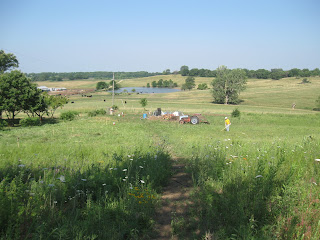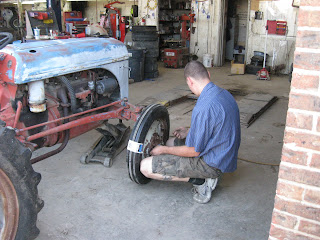Each of our lives is made up of many stories. There are times in life when you go out and find a story like when you go on a great vacation somewhere exotic, go see a great show or something similar. Other times, a story happens to you like when you see an amazing rainbow, win a prize, or stumble into a new friendship. This story is a bit of both. Its also long, so get comfortable!
First, a touch of background. Where we turn off of Hwy 24 to go up to our farm, there is a good sized established farm. It’s currently planted to a mix of wheat and corn. On Saturday when we drove to our farm, the wheat had been harvested and the straw was still in the field. Fast forward to Saturday afternoon, Jacob and I are going to see a friend of mine about 5 miles away. On the way, we passed this farm and saw an older farmer working on a baler in his driveway by the road. There was a bale of straw in the chute. Could it really be possible for us to get the straw for our house from less than a mile away? I had to stop and find out, so I pulled over by the driveway and the farmer walks over. Our conversation goes something like this:
Me: “Looks like you’re baling straw.”
Him: “Yes I am.”
Me: “What are you going to do with the straw?”
Him: “Oh, I’ll probably sell it.”
Me (starting to get excited): “Where are you going to sell it?”
Him: “I don’t know.”
Me: “Would you consider selling it to me?”
Him: “Well, how much do you need?”
Me: “About 8000 lbs and we’re happy to move it for you.”
Him (getting excited): “Sounds good.”
Me: “How much were you thinking of charging?”
Him: “Well, if you’re going to move it, probably $1.75-$2/bale.”
Me: “Can you hold on to it while we get this hoop house built so that we have a place to store it?”
Him: “How long?”
Me: “Hopefully just until the end of the month.”
Him: “Sure.”
Sold – that’s the cheapest and the most local straw we’re going to find for insulating our cottage. I proceed to give him my phone number, tell him where we’re staying this weekend and take down his number. We proceed on to my friends and then back to the farm.
Jump forward to Sunday. We’ve just finished spending the morning mowing and building a giant compost pile (see previous post). We’re hot and tired and looking forward to a relaxing afternoon. After lunch, we were all chilling and mostly asleep when a truck pulls up our drive by the RV and out pops the old farmer (Lewis). He says he’s ready for us to come get the straw out of the field because it looks like weather will be moving in that night. Ok then – guess we’re going to go move some straw.
We unloaded everything from the back of the truck figuring we would drive the truck and trailer through the filed to pick up bales. We were thinking they would be stored in the large barn next to the field, so this shouldn’t take long. Off we go to the farm where the adventure really began.
First, we discovered that truck exhaust can ignite the straw, so the trailer would have to be pulled by a tractor through the field. Ok, no worries. We unhitch the trailer and park the truck there. The farmer pulls up in his tractor then asks if we can use the ball off of our trailer hitch because he doesn’t have one. Sure – that’s no problem, right? Well, after locating 2 pipe wrenches to get the ball off the receiver hitch, we had it all hooked up and ready to go out in the field. This is when we find out that the bales will be stored at a different barn that is about 5 miles up the road from where we are and we realize this is going to take longer than we thought. Then the farmer proceeds to tell Jeremy how to work his tractor and he turned us loose in the field.
Now it’s up to us with a tractor we’ve never driven hooked to a trailer and a field of straw with bales scattered all over. We’re game, so off we go. We load up the trailer with 47 bales stacked 5 bales high. There was something really deeply awesome about walking around the field and picking up the straw that will go into our house less than a mile away. Part of me couldn’t believe that this was really happening. We were also feeling the pressure because there were rain clouds building to the west and we knew that the straw can’t get wet if we want to build with it.
We get back to the farmhouse with the first trailer load and the farmer pulls up with another longer trailer. Cool – this will go faster if we can do 2 trailers at a time. We switch it over and off we go into the field again. This one held 88 bales. About a third of the way through this trailer, I look at Jeremy and say, “You can add this to the list of things we couldn’t do 5 years ago!” and it is all too true. It has taken that long for us to be in good enough shape to even consider moving 200+ bales of straw, twice, in an afternoon.
While we loaded the second trailer, the farmer and his wife went to a 50th anniversary party. They weren’t back by the time we finished loading the trailer so I took the truck and got Jacob. We had left him at the RV thinking that we’d only be gone a couple of hours. Clearly that was not to be the case, so Jacob became our photographer again.
Now for the next bend in the story. We have 2 trailers and only 1 ball. The big trailer is attached to the tractor and the farmer proceeds to tell us that we can follow him up to his other barn while he pulls the trailer on the tractor. Five miles isn’t a long way, but when the vehicle you’re following can only get up to about 12 miles an hour, it takes a really long time! It was now about 5:00.
It took about 20 minutes to go the 5 miles to the other barn. Along the way while shifting around and admiring the wonderful purple color on my forearms, I kicked something hard in the floorboard. Yes, there are enough things currently in the floorboard of the truck that I didn’t immediately know what it was. It was the receiver hitch and ball to my brother’s truck that we had borrowed before we got our own. We have a second ball! That meant that we could leave one on the tractor while someone else pulled a trailer to unload with the truck. Eureka! We might get finished by midnight…
The farmer left the trailer with us since we could now pull it back and he headed back to his farm. We unloaded the big trailer and stacked the bales as high as we could reach from the ground (6 layers) making a solid wall of straw about 6 feet tall. Then it was back to the farm to get the rest of the bales while watching the clouds to the west. Could we get it all done in time?
We picked up Catherine from her sleep over on the way back so the whole family was there for the finale. We loaded up the big trailer again – this time with about 100 bales stacked 6 high. Getting them that high involved a lot of climbing up on the load and moving bales from a lower layer up to the 6th layer – any taller and it wouldn’t have fit under the rafters in the storage barn. Jacob got to ride through the field on the bales while Jeremy and I loaded them - every farm kid's dream, right? Meanwhile, we were getting really tired and continuously eyeing the clouds and listening for thunder. It was getting dark and we still had to unload this trailer and our trailer.
Last trailer
Our official photographer finally makes it into a picture with the last trailer load
The farmer kindly offered to let us store the 47 bales from our trailer in his barn by the field, so we quickly unloaded that. He even helped with his son! That was actually kinda fun – the kids shifted bales over to the adults who hauled and stacked them in the barn. It didn’t take long to empty our trailer. Then we were off to the other barn towing the very fully loaded big trailer.
We had a limited footprint to use in the barn, so we stacked the bales up to the rafters. That required me being up on the bale wall while Jeremy threw bales over from the trailer (remember that the trailer is also stacked 6 bales tall). We managed to fit all the bales into the space we were allotted, just.
The wall of bales - if you look closely, you'll see the rafters at the top of the picture!
Jeremy dropped the kids and I off at our farm to fix some dinner and pack while he took the big trailer back and picked up ours. We finally made it home about 10:30 and in bed about midnight. What a day!
Looking back on it now that my hands will grip again and the sunburn has turned into a tan, it was a great experience. I can’t believe that we stumbled into straw that close to home from a farmer kind enough to store it for us and for a price that was less than we budgeted. Deals don’t get much better than that. The afternoon of work was hard and exhausting, but also rewarding and fun. We took the first concrete step toward building our cottage, met our very nice neighbors and spent a gorgeous afternoon outside. I would do it again in a heartbeat.
Sometimes a story stumbles into you and sometimes you stumble into a story. This time, we took the first step and the rest of the story just kinda happened. Thanks for reading it all!







































